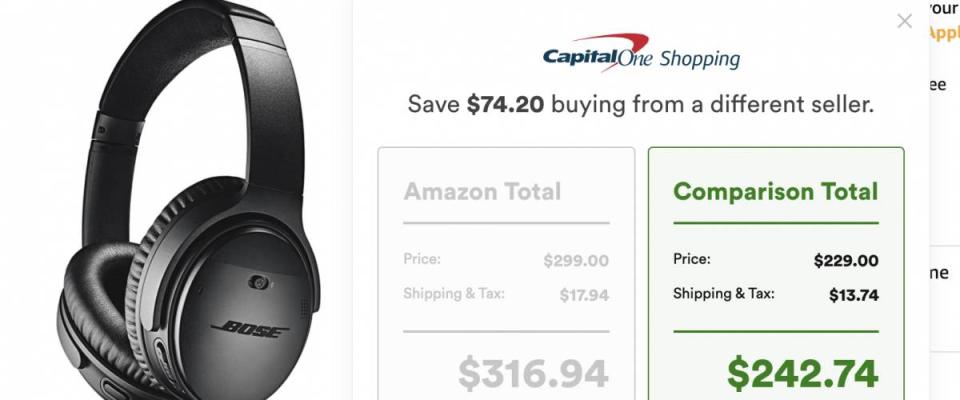Refunds without returns — and 5 other ways online shopping is getting better

The pandemic is far from the only reason people are abandoning brick-and-mortar stores by the millions.
Online retailers are always devising some new strategy to make your experience faster, cheaper and more convenient. While they might be confident that you’ll choose to shop from the comfort of your couch instead of putting on your shoes, they still need to compete with one another.
At the same time, new software is finally giving consumers the advantage over big businesses, helping them hunt down lower prices and squeeze out extra discounts on every purchase.
Here are a few ways online shopping is getting even better, including some tricks you can use today to shrink your shopping bill.
1. Compare prices at a glance

Savings found on Jan. 21, 2021. Savings may vary. Sample results shown.
Whether you’re buying day-to-day essentials like batteries or splurging on a pair of noise-cancelling headphones, it’s always important to do your research.
After checking out customer reviews, you’ll want to compare prices from different online stores in search of the best available deal. Unfortunately, the internet is a big, big place — you could spend hours researching dozens of retailers that carry that product. Then you’d have to do it all again for the next item on your list.
Today the process can be a lot simpler with free browser extensions. Just start browsing on a big site like Amazon or Target, and the software will scan the internet for lower prices at other retailers.
This free browser add-on takes extra costs like shipping into account, so you can save money on the things you buy online while skipping all of the homework.
2. Don’t return it, just keep it

It still feels like magic to buy something with a few clicks, then have it appear at your front door. Returns still feel miserable, though, as you package the item back up, bring it to the post office and wait ages for your refund to arrive.
Well, it turns out that processing online returns can be as inconvenient for retailers as it is for buyers. That’s why most companies encouraged shoppers to return items in-store back in the pre-pandemic days.
Now big retailers like Amazon and Walmart are using artificial intelligence to rethink the return process — sometimes eliminating it entirely.
If an item is too cheap or too bulky to retrieve profitably, companies have started allowing customers to keep the purchase and get a refund. Walmart tells The Wall Street Journal that the decision is also influenced by the customer’s purchase history, so don’t get any funny ideas about abusing the system.
3. Fresh food — whenever

Grocery delivery and pickup have become way more popular than they used to be, but it’s far from a perfect system. Fresh and frozen foods present plenty of logistical challenges that are only now being overcome.
Walmart is piloting a grocery delivery program in Arkansas that places temperature-controlled smart coolers at your doorstep.
Customers don’t need to plan their day around the time of their delivery; they can just leave home, come back and grab their goodies at any time. The coolers have separate zones for frozen, refrigerated and pantry foods and will only open for the homeowner or delivery driver.
Meanwhile, one grocer in Chicago is trying out an automated pickup kiosk. Shoppers pick a two-hour window and scan their code at a kiosk, where their items are waiting to be delivered robotically.
The kiosk also includes a deep freeze zone, so you can order tubs of Ben & Jerry’s without them turning into strawberry and chocolate flavored puddles by the time you arrive.
4. Apply available coupons, automatically

Online coupons are a drag. Your inbox is always full of coupons for stuff you don’t want, and you never have a relevant coupon handy when it’s time to buy something you do want.
Even when you do find a promo code for something you want, half the time it’s expired.
Thankfully, there are free browser extensions that help fix this problem.
They maintain a database of coupon and promo codes that have worked for other users in the past. When you go to checkout, the plugin will hunt down and apply any available codes automatically, saving you money and no small amount of frustration.
5. “Try before you buy” via augmented reality

Before the pandemic, furniture and home improvement retailers like Ikea and Home Depot were already offering augmented-reality tools allowing you to see how their products would look in your home.
But with shoppers reluctant to venture into stores and try out clothing and other hands-on products, more businesses are introducing AR into the mix.
Kohl’s collaborated with Snapchat just last summer to create a virtual closet allowing shoppers to “try on” clothes at home.
Some cosmetic companies are experimenting with virtual makeup as well, building on the work Sephora did with a popular app in 2017.
6. Earn rewards for stuff you actually want

Who doesn’t love getting paid to shop?
It’s true that just about every retailer out there offers some kind of loyalty program that rewards you for buying their stuff. However, they’re restrictive by design — you can only rack up points if you’re a regular customer, and you can only spend those points at the very same retailer.
One more benefit of free browser extensions includes access to much more flexible rewards systems.
With browser add-ons installed, you can earn rewards when you buy from a wide range of partnered stores. You can then redeem those credits for gift cards at the store of your choice, like Walmart or Macy’s.
That means you’re never buying junk you don’t want, just to earn or use up points.
